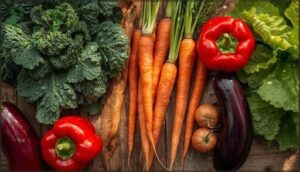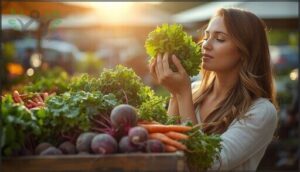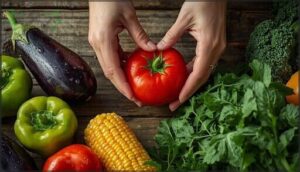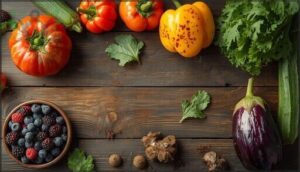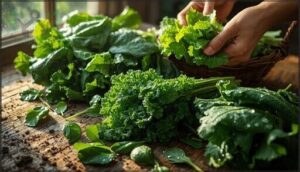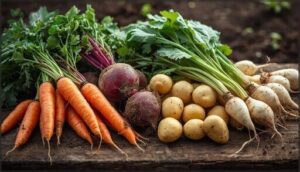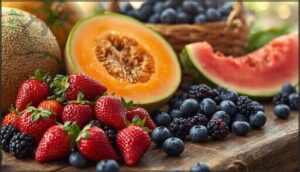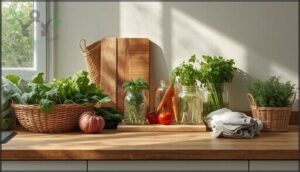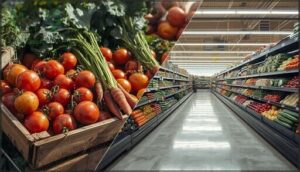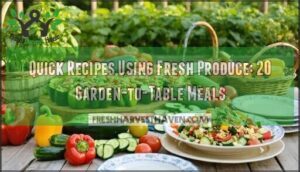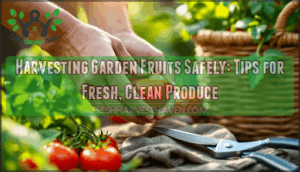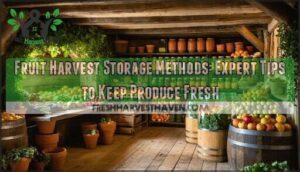This site is supported by our readers. We may earn a commission, at no cost to you, if you purchase through links.
Fresh vegetables lose about 50% of their vitamin C within days of harvest, which means knowing how to pick fresh vegetables can literally boost the nutrients on your plate.
Most people rely on guesswork at the grocery store, grabbing whatever looks “good enough” without understanding the simple clues that reveal true freshness.
The difference between a crisp, flavorful vegetable and one that’s been sitting too long comes down to recognizable signs—vibrant color, firm texture, fresh scent, and proper weight.
Once you learn to read these indicators, you’ll consistently bring home vegetables that taste better, last longer, and deliver more nutrition for every dollar you spend.
Table Of Contents
- Key Takeaways
- Universal Signs of Fresh Vegetables
- How to Assess Vegetable Ripeness
- Recognizing and Evaluating Imperfections
- The Importance of Seasonality
- Picking The Freshest Leafy Greens
- Selecting Quality Root Vegetables
- Pro Tips for Choosing Berries and Melons
- Are Pre-Cut Vegetables Worth It?
- Proper Storage for Maximum Freshness
- Farmer’s Market Vs. Supermarket Shopping
- Frequently Asked Questions (FAQs)
- Conclusion
Key Takeaways
- Fresh vegetables lose up to 50% of their vitamin C within days of harvest, so mastering visual cues like vibrant color, firm texture, fresh scent, and proper weight helps you select produce at peak nutrition and flavor.
- Seasonal vegetables reach you faster—often within 1-3 days of harvest—delivering 30% higher nutrient levels, better taste, and 15-50% cost savings compared to out-of-season options shipped long distances.
- Firmness testing is your most reliable freshness tool across all vegetable types: fresh produce should feel solid and resistant when gently pressed, while softness signals cellular breakdown and spoilage.
- Proper storage techniques can extend vegetable freshness significantly—leafy greens need high humidity (90-98%) at 32-35°F, while root vegetables prefer cool, dark, dry conditions with good air circulation.
Universal Signs of Fresh Vegetables
You don’t need a degree in agriculture to pick great vegetables—you just need to know what to look for. The freshest produce shares a few telltale signs that work across nearly every type, from broccoli to bell peppers.
Here’s what to check every time you shop.
Vibrant Color and Visual Appeal
You can judge a lot about a vegetable just by looking at it. Vibrant colors—deep greens in leafy greens, bright oranges in carrots—are your best visual cues for freshness. Research shows that vegetables with uniform, saturated color are perceived as fresher by over 90% of shoppers.
Faded or uneven color often signals aging or poor storage, so trust your eyes. Color retention is one of the most reliable shelf life predictors you’ve got. Checking for produce freshness indicators can also help you make a more informed decision.
Firmness and Texture
Beyond color, firmness is your go-to test—65% of consumers rely on texture to gauge freshness and vegetable ripeness. Gently press the surface: fresh vegetables should feel firm and slightly resistant, not soft or spongy. That’s because firmness measurement actually reflects cellular integrity, and softening is one of the earliest spoilage indicators.
Root vegetables and greens respond differently to cooking effects, so always start with the firmest you can find. Understanding the role of texture analysis is essential for determining the quality of vegetables.
Fresh Scent Indicators
Your nose knows freshness—trust it. Fresh vegetables emit natural, pleasant aromas from VOC compounds; spoilage odors like fermentation signal decline.
Olfactory perception often catches aroma changes before your eyes spot trouble, making scent a reliable sensory evaluation tool.
Leafy greens should smell earthy and clean, while Brassicas have a mild pungency when fresh. Off-odors mean walk away—that’s your best freshness safeguard.
Weight and Juiciness
Pick up that vegetable—does it feel heavy for its size? That’s your signal. Fresh produce holds 85 to 95 percent water content at harvest, giving you those freshness metrics you need.
Juiciness tests work because moisture retention equals quality. Use density measures alongside firmness and vibrant color checks.
When weight feels right, you’ve found produce with peak juiciness and supreme freshness.
How to Assess Vegetable Ripeness
Ripeness is the sweet spot where vegetables have reached their peak flavor and nutritional value, and learning to recognize it means you’ll consistently bring home the best produce.
You’ll rely on three key signals your senses naturally pick up on: what the vegetable looks like, how it feels when you touch it, and what it smells like up close.
Here’s how to read each clue with confidence.
Color Changes and Maturity
When you see a tomato shift from green to deep red, you’re watching chlorophyll degradation and carotenoid accumulation in action—nature’s ripeness indicators. Bell peppers transform through anthocyanin production, moving from green to purple or red.
Visual assessment matters: vibrant colors signal maturity. Visual inspection tips include checking for uniform color changes that match seasonal knowledge. This color-based ripeness maturity evaluation helps you pick vegetables at their nutritional peak.
Texture and Gentle Pressure
Firmness testing is your best tactile assessment tool. Apply gentle pressure to carrots or cucumbers—fresh vegetables should feel hard, not spongy. Industry texture analysis shows that vegetables lose up to 40% firmness within 72 hours of poor storage.
Crunchiness evaluation matters too: springy, resilient texture signals freshness.
Visual inspection tips combined with firmness testing give you confidence in selecting vegetables that’ll stay fresh longer.
Scent as a Ripeness Clue
Your nose is a powerful ripeness tool. Fresh vegetables release over 300 volatile organic compounds that create their characteristic aroma.
When you smell sweet, earthy notes in tomatoes or melons, you’re detecting peak freshness. Sour or fermented odors? That’s spoilage talking.
Research shows scent detection helps shoppers identify ripe produce correctly 85% of the time—trust those aroma compounds as reliable ripeness markers.
Recognizing and Evaluating Imperfections
Not every imperfection means you should skip a vegetable. Some marks are purely cosmetic and won’t affect flavor or nutrition, while others signal real spoilage you’ll want to avoid.
Learning to tell the difference helps you make smarter choices and waste less food.
Distinguishing Cosmetic Flaws Vs. Spoilage
Not every mark on a vegetable means it’s headed for the trash—knowing the difference saves money and cuts food waste. Visual inspection is your first line of defense: cosmetic damage like minor blemishes or odd shapes doesn’t harm edibility, while spoilage signs demand attention.
- Cosmetic flaws: Small scars, discoloration, irregular shapes (safe to eat)
- Spoilage signs: Mold growth, mushy spots, off odors, decay (discard immediately)
- Freshness tests: Firm texture, no leaking fluids, minimal bruising
When Blemishes Are Acceptable
Minor surface scars, slight discoloration, and odd shapes won’t hurt you—they’re just cosmetic standards at work. Research shows blemished vegetables retain full nutritional value when imperfections don’t involve mold or rot.
Visual inspection of produce helps you spot the difference: firm texture signals freshness, while blemish tolerance reduces food waste.
Choosing sustainable produce with small flaws benefits your wallet and the planet without sacrificing quality.
Avoiding Overripe and Damaged Produce
You can’t afford to bring home vegetables that’ll spoil within hours. Overripe produce with soft spots, bruises, or cuts harbors bacteria that accelerate decay—the FDA links damaged vegetables to foodborne illness outbreaks.
Gentle pressure reveals excessive softness, while mold or shriveling signals trouble. Your produce inspection skills drive spoilage control and food waste reduction.
Freshness testing through damage prevention keeps your family safe and your grocery budget intact.
The Importance of Seasonality
Buying vegetables in season isn’t just a nice-to-have—it’s one of the smartest moves you can make for flavor, nutrition, and your wallet. When you choose produce at its natural peak, you’re getting food that’s spent less time in transit and more time ripening the way nature intended.
Buying vegetables in season delivers the smartest combination of peak flavor, maximum nutrition, and real savings on every trip to the store
Let’s look at why seasonality matters so much and how you can use it to your advantage every time you shop.
Why Seasonal Vegetables Are Fresher
Seasonal vegetables reach you faster, plain and simple. When produce grows during its natural cycle, it travels shorter distances and spends less time in transit—often just 1 to 3 days from harvest to your hands.
- Shorter travel means better flavor and crispness
- Nutrient levels stay 30% higher in locally sourced options
- Less refrigeration preserves natural texture and moisture
- Peak ripeness happens on the plant, not during shipping
- Fresher vegetables spoil 15–35% less quickly
That’s the power of eating with the seasons.
Benefits of In-Season Selection
Picking in-season vegetables delivers more than just freshness. You’ll boost your nutrient intake by up to 30%, save 15–50% on grocery costs, and support local farmers who grow with fewer chemicals. Plus, you’re cutting carbon emissions by reducing food miles. Each season offers unique flavors and textures you won’t find year-round.
| Benefit | Why It Matters |
|---|---|
| Nutrient Boost | 30% higher vitamins and antioxidants |
| Environmental Savings | 40% less water and fertilizer needed |
| Local Support | Strengthens your community’s economy |
How to Identify Seasonal Produce
Knowing what’s in season isn’t as hard as you’d think. Check your grocery store for labels highlighting local and seasonal produce, or visit farmers’ markets where vendors sell what’s just been harvested. Seasonal guides online show regional variations and harvest cycles throughout the year.
Look for freshness indicators—bright colors, firm texture, heavy weight—and you’ll spot seasonal highlights naturally, supporting local sourcing while getting peak flavor.
Picking The Freshest Leafy Greens
Leafy greens can be tricky because they lose freshness faster than most vegetables, but you can master the art of picking the best bunch every time. Your eyes and hands are your best tools here, helping you spot the difference between crisp, vibrant greens and those past their prime.
Let’s walk through the key signs that tell you which greens to grab and which to leave behind.
Crispness and Color
When you’re choosing fresh leafy greens, crispness testing and color measurement go hand in hand. Vibrant, deep greens signal peak freshness—dull or faded leaves mean they’ve lost nutrients and appeal. Use sight, smell, and touch: crisp stems and firm leaves indicate freshness, while limp texture shows staleness. Visual inspection reveals freshness indicators instantly.
Selecting fruits and vegetables gets easier once you trust firmness and texture as your guide.
Avoiding Wilting and Yellowing
Wilting causes include water loss and poor storage techniques—both speed leaf senescence and rob you of nutrients. Yellowing prevention starts with proper storage humidity and ethylene control, protecting freshness and extending shelf life.
- Store leafy greens at 36–41°F to slow wilting by up to 22%
- Maintain 90–95% humidity to preserve crispness and prevent dehydration
- Dry greens thoroughly before refrigerating to add 2–4 days of freshness
- Use airtight containers to reduce yellowing by 40% over one week
- Keep greens away from ethylene-producing fruits like apples or bananas
Checking Stems and Roots
When you inspect the stems, look for a vibrant green color—retailers use this as a top freshness indicator. Firm, crisp stems that snap cleanly signal strong vegetable hydration and proper root moisture, while mushy or darkened ones point to spoilage.
For root vegetables, check root firmness and smoothness; shriveled roots lose moisture fast, compromising both leafy greens and overall vegetable freshness.
Selecting Quality Root Vegetables
Root vegetables are some of the most forgiving produce you’ll find, but that doesn’t mean they’re all created equal. When you know what to look for, you can grab the freshest carrots, beets, potatoes, and turnips every time.
Here’s how to spot the keepers and skip the ones that have seen better days.
Firmness and Smoothness
When you’re selecting fresh vegetables, firmness testing is your best friend—think of it as a gentle handshake that reveals quality. Press lightly on root vegetables like carrots and potatoes; they should feel solid and resist your touch.
Surface smoothness matters too, since wrinkled or rough texture signals dehydration.
These freshness metrics help you master vegetable selection confidently, ensuring you bring home produce that’s crisp and nutritious.
Signs of Aging or Spoilage
Root vegetables past their prime show clear spoilage indicators you can’t miss. Watch for mold detection opportunities—dark spots or fuzzy patches mean immediate discard. Texture changes like mushiness or wrinkled skin reveal dehydration and aging.
Soft spots and bruises signal cellular breakdown, while odor analysis helps catch spoilage early—any sour or off smell means it’s time to toss it. Freshness testing through your senses keeps you safe.
Choosing The Right Size
Size matters more than you might think when choosing root vegetables. Aim for carrots around 1.5 to 2.5 cm in diameter and beets at 5 to 6 cm—that’s when you’ll get ideal vegetable size for tenderness and sweetness. Larger isn’t better here; oversized roots often develop woody cores and mealy texture.
Heavy for its size indicates juiciness, while gentle pressure helps you assess firmness and quality.
Pro Tips for Choosing Berries and Melons
Berries and melons can be tricky because they don’t ripen much after you buy them, so you need to choose wisely at the store.
A few simple checks—like color, scent, and sound—can help you spot the sweetest, juiciest options every time.
Here’s what to look for when you’re picking out these delicate fruits.
Color and Scent in Berries
Regarding berries, your eyes and nose are your best tools. Look for these ripeness indicators:
- Strawberries should display bright, uniform red coloring with a sweet, floral scent
- Blueberries need deep blue or purple hues and a strong, pleasant aroma
- Avoid berries lacking scent or showing uneven color
Berry varieties ripen differently, so trust both berry coloration and scent analysis for freshness cues.
Field Spot and Sound in Melons
When choosing melons, two simple tricks reveal melon ripeness and quality. First, inspect the field spot—that pale patch where the melon rested on soil. A dark yellow or golden field spot color signals high sugar content and full ripeness, while pale spots mean premature picking.
Second, tap the melon for acoustic testing. A hollow sound indicates ideal texture and freshness, whereas a dull thud suggests overripeness.
Checking for Mold or Soft Spots
After you’ve checked the field spot and sound, don’t forget Mold Detection and Soft Spot Prevention. Run your eyes and fingers over berries and melons. Look for fuzzy mold, mushy patches, or strange odors—these are Spoilage Signs.
For top Vegetable Inspection, remember:
- Scan for discoloration and fuzz
- Test firmness with gentle pressure
- Trust your nose for freshness
Are Pre-Cut Vegetables Worth It?
Pre-cut vegetables promise quick prep, but there’s more to think about than just convenience. You’ll want to weigh freshness, cost, and quality before tossing them in your cart.
Here’s what you should look for when deciding if they’re right for you.
Shelf Life and Freshness
Freshness Testing matters most with pre-cut veggies, since their shelf life is much shorter than whole produce. For spoilage prevention, check for vibrant color and a fresh scent—these are key freshness indicators.
Storage tips? Keep pre-cut vegetables in the fridge at ideal temperature and humidity. Proper storage techniques help preserve vegetable freshness, but even then, they won’t last as long.
Cost Vs. Convenience
You’ll notice that Price Comparison in grocery aisles often shows pre-cut veggies cost more—sometimes triple—thanks to Convenience Fees. For many, Time Savings outweigh Freshness Tradeoffs, especially on busy nights.
Smart Budget Strategies might mean mixing whole and pre-cut options. If you’re watching spending, selecting produce at farmers markets or choosing conventional over organic can help stretch your food shopping dollars.
Signs of Quality in Pre-Cut Produce
A sharp eye makes Pre-cut inspection easier. You want Packaging quality—sealed, undamaged, and with a recent pack date.
Look for these Freshness indicators:
- Bright, uniform color and no browning on edges
- Firm, crisp Texture without mushiness or excess moisture
- Mild, pleasant scent—never sour or musty
Smart Produce Selection means trusting these Visual Cues.
Proper Storage for Maximum Freshness
Keeping vegetables fresh starts with how you store them at home. The right techniques can make a big difference in taste, texture, and nutrition.
Here’s what you need to know to get the most out of your produce.
Storing Leafy Greens
Did you know leafy greens last longer when you treat them like delicate flowers? Cold storage at 32-35°F with ideal humidity—around 90-98%—keeps them crisp.
Use a crisper drawer for reliable moisture control, and wrap greens in paper towels to absorb excess dampness. These storage techniques help prolong freshness retention, so your salads stay vibrant and delicious.
Best Practices for Root Vegetables
Root Vegetable Handling is all about keeping flavor locked in. For top Vegetable Quality, follow these Vegetable Storage Tips:
- Store in a cool, dark place—never the fridge for potatoes.
- Keep roots dry to prevent mold.
- Use breathable bags for air flow.
- Remove wilted tops for longer life.
Soil Quality Matters, but smart Storage Techniques protect Vegetable Freshness after Harvesting.
Using Crisper Drawers and Humidity Control
Think of your crisper drawer as your vegetable safe—humidity settings are the key. High humidity keeps leafy greens crisp, while low humidity slows fruit decay by controlling ethylene. For shelf life extension and freshness retention, separate produce by humidity needs and use breathable storage bags.
Here’s a quick guide:
| Produce Type | Humidity Level | Storage Technique |
|---|---|---|
| Leafy Greens | High | Moist towel wrap |
| Fruits (Apples) | Low | Vent open, separate |
| Root Vegetables | Moderate | Breathable bag |
| Berries | High | Single layer, dry |
Farmer’s Market Vs. Supermarket Shopping
You’ve probably noticed that vegetables from the farmer’s market often look, smell, and taste different than what you find at the supermarket. Both shopping options have their place, but understanding the real differences helps you make smarter choices for your kitchen and budget.
Let’s compare what each offers so you can decide where to shop for the freshest, most flavorful vegetables.
Advantages of Local Produce
Local farmers market shopping delivers benefits far beyond the produce itself. You’re supporting your community’s economy while reducing environmental impact through fewer food miles. Local farms often embrace sustainable practices, and seasonal produce reaches you at peak nutrient retention and freshness. Here’s what you gain:
| Benefit | Why It Matters |
|---|---|
| Economic Benefits | Direct support creates nearly 32 jobs per $1 million in revenue |
| Environmental Impact | Shorter transport means lower carbon emissions |
| Nutrient Retention | Less time in transit preserves vitamins and minerals |
| Community Support | Money circulates locally, strengthening your neighborhood |
How to Spot The Freshest Options
Wherever you shop, use your senses as freshness tests. Vegetable inspection starts with vibrant color and firm texture—these are your reliable quality checks. Combined flavor and texture cues boost identification success from 39% to 87.5%, so don’t skip the gentle squeeze.
Here’s your produce selection framework:
| Sense | What to Check | Red Flags |
|---|---|---|
| Sight | Vibrant, uniform color | Dull patches, dark spots |
| Touch | Firm, crisp texture | Sliminess, mushiness |
| Smell | Pleasant, characteristic aroma | Sour or faint odors |
| Weight | Dense, heavy for size | Light, shriveled appearance |
| Surface | Intact, unblemished skin | Extensive bruising, cuts |
Evaluating vegetable ripeness means examining produce texture alongside these visual cues. This systematic approach ensures food safety and maximum nutrient retention every time you shop.
Tips for Smart Vegetable Shopping
Smart shopping starts with meal planning and grocery lists—this simple habit cuts waste by up to 25% and keeps you focused on fresh picks. Shop the perimeter first, where stores display their freshest produce, then compare unit prices to stretch your budget. Choosing fresh produce seasonally saves you 20-30% while delivering better flavor and nutrients.
| Strategy | Action | Benefit |
|---|---|---|
| Plan ahead | Create meal-based lists | Reduces waste 25% |
| Shop perimeter | Start with produce section | Increases vegetable purchases 40% |
| Buy seasonal | Choose in-season varieties | Saves 20-30% on costs |
Frequently Asked Questions (FAQs)
Can frozen vegetables be as nutritious as fresh?
Yes, frozen vegetables can match or even exceed fresh ones nutritionally. Flash freezing locks in nutrients at peak ripeness, while fresh options lose vitamins during transport and storage.
How do you wash vegetables properly before eating?
Rinse your vegetables under cool running water right before eating, rubbing them gently to remove dirt and bacteria. Use a soft brush for firm produce like potatoes, and skip the soap—water works best.
Which vegetables ripen after being picked at home?
Climacteric types like tomatoes, hot peppers, and tomatillos continue ripening at home through ethylene gas production, usually taking four to ten days at room temperature.
Meanwhile, non-climacteric vegetables won’t improve after harvest.
Whats the best time of day to buy produce?
Shop early morning, between 8 a.m. and noon, when stores complete daily inventory and fresh delivery arrives.
Peak shopping hours align with store restocking schedules, giving you first access to morning harvest produce at maximum freshness.
How can you tell if organic vegetables are fresher?
Organic vegetables often feel firmer, smell earthier, and show natural imperfections—signs of freshness.
Look for vibrant color, heavier weight, and seasonal produce from local sources to guarantee peak nutrient content and quality.
Conclusion
Pick with your eyes, press with your fingers, smell with intention—these instincts separate mediocre meals from nutrient-rich ones. When you learn how to pick fresh vegetables, you’re not just shopping smarter; you’re investing in flavor, longevity, and the vitamins your body craves.
Every trip to the market becomes an opportunity to bring home produce that truly performs. Trust the signs, honor the seasons, and watch your kitchen transform into a place where freshness isn’t luck—it’s skill.
- https://papers.ssrn.com/sol3/papers.cfm?abstract_id=4819078
- https://research.tudelft.nl/en/publications/consumer-expectations-for-vegetables-with-typical-and-atypical-co
- https://www.produceretail.com/indicators-of-produce-freshness-for-retailers/
- https://pmc.ncbi.nlm.nih.gov/articles/PMC7554949/
- https://ift.onlinelibrary.wiley.com/doi/10.1111/j.1365-2621.1982.tb10099.x


